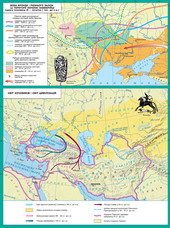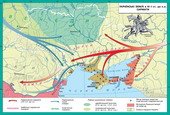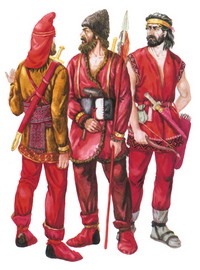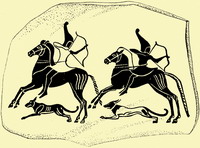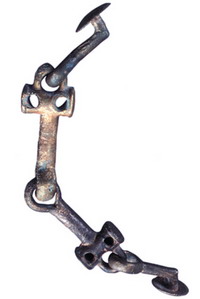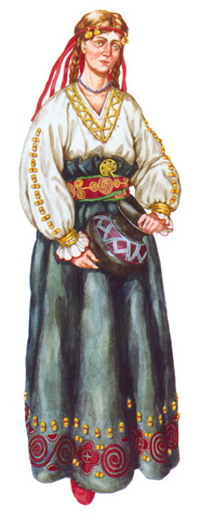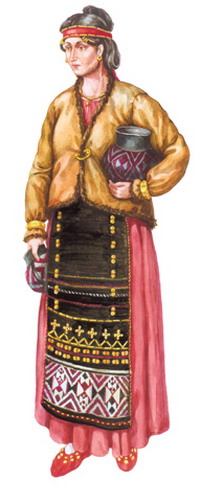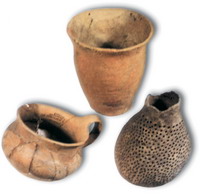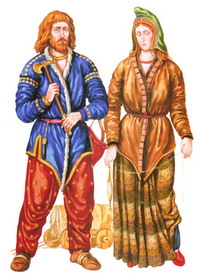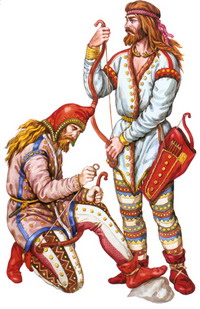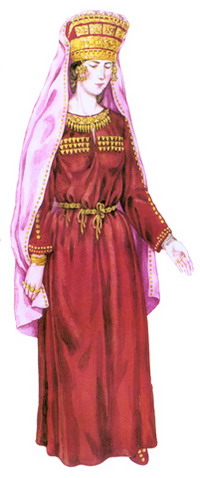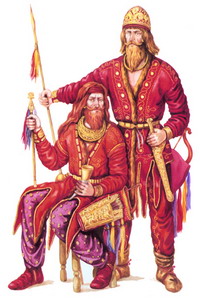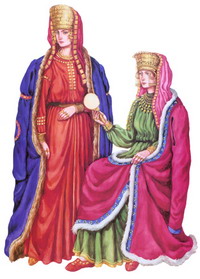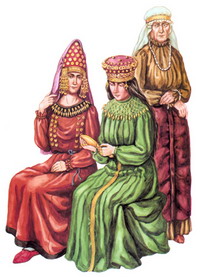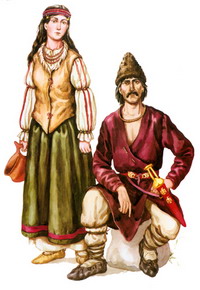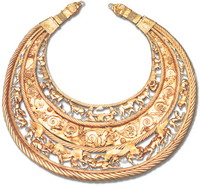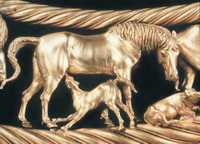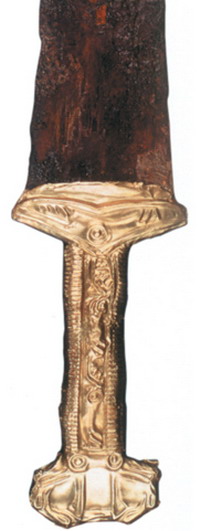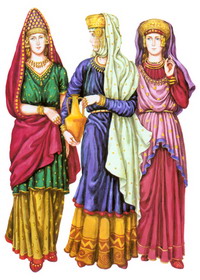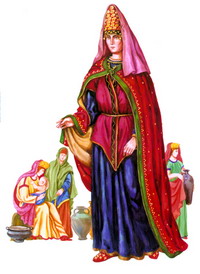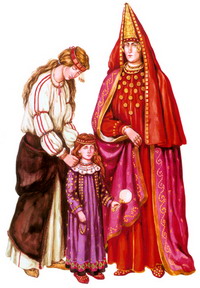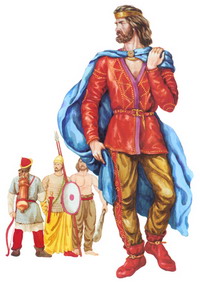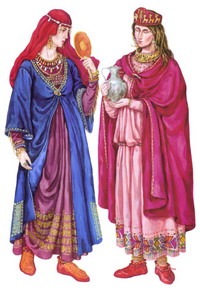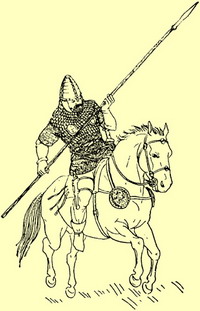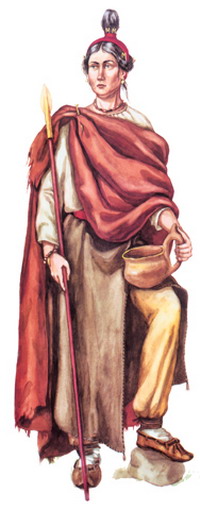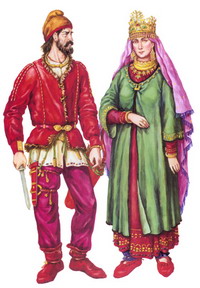Early Iron Age in Ukrainian lands. World nomads
Plan presentation
- Early Iron Age.
- Cimmerians.
- Hiking Cimmerians farmers against Forest. The author culture.
- Scythians: resettlement and employment.
- Great Scythia. The spiritual world of Great Scythia.
- Sarmatians.
Timeline
|
722 - 705 BC |
Hiking Cimmerians in Asia Head |
| 7 of art. BC |
Scythian invasion on the Black Sea |
| 5 - Article 4. BC |
Day heyday of the Scythian state ( Great Scythia) |
|
514 BC |
Scythian king Darius of Persia |
|
3 tablespoons. BC |
Invasion Sarmatian tribes |
|
3 tablespoons. BC - beg. Article 4. BC |
Lesser Scythia |
basic concepts and terms
Early Iron Age - one of the periods of human development for archaeological classification. Indo-noted separation, technological perelamom in making implements and weapons, the emergence of the first state formations, the brightest period of the nomadic communities. In Ukraine, this day falls on the pre BC - The beginning of thousands BC and chronologically corresponding Cimmerian, Scythian and Sarmatian dobam history.
Persons
Herodotus - a distinguished historian of ancient Greek. Many traveled to Asia Minor, was in Egypt, Babylon, Phoenicia, Syria, the Western Black Sea, Olbia. Author labor conventionally called the "history" which is the first broad historical narrative of the state and peoples of Asia and Europe. Outlining the different versions, Herodotus showed a critical attitude to the material collected. Even in antiquity Herodotus called the "father of history". In Hellenistic Alexandria scientists shared a "history" Herodotus Book 9 (the number of Greek music). The fourth book is a valuable source of history, ethnography and geography of the Northern Black Sea.
main presentation
1. Early Iron Age
- affirm iron as the most common metal in the lands of Ukraine took place in the 7 century. BC. BC, as evidenced by archaeological materials.
- appearance of iron tools and weapons led to rapid growth economy and military.
- agricultural tribes began to use iron plow , through which you can plow more land, and thus - to gather the best yields.
- cattleman desert for that era healed nomadic life, constantly moving with the herds to new lands. They learned to ride horses and overcome these fleet-foot animals vast distances.
With the discovery of iron - nomadic pastoralists to become invincible warriors. History warlike nomads in our land started Cimmerians .
2. Cimmerians
Evidence sources of Cimmerians
-


 Cimmerians - a nomadic Iranian people who prymandruvav of Lower Volga region in the Black Sea steppes in 9 century. BC. BC and ruled for two centuries here.
Cimmerians - a nomadic Iranian people who prymandruvav of Lower Volga region in the Black Sea steppes in 9 century. BC. BC and ruled for two centuries here.
- Cimmerians - the first people in our land, whose name we all know. They saved her written sources, though not of the Cimmerians, as they had no written language, and the Assyrians and Greeks.
- earliest mention of the Cimmerians is contained in the famous "Odyssey", and vivid - the work of Herodotus.
- mysterious and incomprehensible released inhabitants of the Black Sea steppes Greek authors.
- Homer, in particular, called their strange mare milker and molokoyidamy, land which odviku "clouds and mloyu vpovyta.
- The real features of the Assyrian and Babylon full testimony of the Cimmerians, because the peoples of the Middle East had to go through their invasion.
Cimmerians - soldiers
- All written mention of the Cimmerians related to their military campaigns.
Cimmerians - army consisted of troops moving riders.
- According to archaeological finds, to his time Cimmerians were unsurpassed masters of military equipment.
- Cimmerian warriors main weapon was a powerful long-range bow. In close combat they used iron swords length of meter.
About - perfect horse harness Cimmerians the fact that he borrowed the then people.
For the history of peoples who inhabited the lands of Ukraine in the old days, this fact is important because it Cimmerians were the first among the steppe inhabitants learned to produce iron, which is why they associated with the beginning of Iron Age our steppe area.
Lifestyle Cimmerians
- Cimmerians were the first people in the Ukrainian lands, which the researchers called nomadic .
- Cimmerians do not build homes and their lives ran together in an endless journey across the steppe, or on horseback, or in litters, drawn by oxen. The basis of their economy was Horse . The things they could not give horses Cimmerians conquered.
3. hikes Cimmerians farmers against Forest. Chornoliska Culture
military campaigns Cimmerians plagued not only the peoples of the Middle East. Domination in the Black Sea steppes, they could not avoid the world of farmers steppes. The lands of the middle Dniester River in the west to the middle reaches of Vorskla east at that time was inhabited by numerous tribes, which archaeologists call chornoliska native culture.
- culture received its name from the great Black Forest, in the upper Stepan Makarov, which found its sights.
- Archaeological finds show that they grew millet, barley, rye, wheat. Harvest collected bronze sickles and kept it in special holes made in the floor dwellings.
- grains was about enough to keep a large herd of pigs. In addition, chornolistsi bred cows, goats, sheep, horses.
- , most impressive skill chornoliska blacksmiths. Archeological lucky to find a steel sword length 108 cm
- first attack Cimmerians chornolistsi already suffered from the beginning of their domination of the plain. But the most acute confrontation it was in the 8 century. BC. e. Then there were strong defensive line of the many castles, ancient settlements along Tyasmyn, and in the Black Forest - surrounded with three rows of walls and ditches Settlement.
- fight against Cimmerians was cruel attacks of the nomads ended most destructive fire, many chornolistsiv fell into captivity.
- Numerous archeological finds show that the end of eight centuries. BC. BC Cimmerians overcome resistance chornoliska population penetrated deep into their land and captured the most important city.
Consequently - among chornolistsiv land spread things Cimmerian sample, especially weapons and horse gear. But even that seemed invincible warriors Cimmerians in 7 of art. BC. e. their domination in the desert urvalosya and they scattered, subdued much more powerful tribes Scythians .








4. Scythians: resettlement and lessons
In the Black Sea steppes
they prymandruvaly a foot of Caucasus steppe regions. As Cimmerians, Scythians were nomads , which was based economy Horse .
- Similarly they have experience hiking in the country's Front Asia. However, to stubbornly resist narazyvshys had to change the direction of campaigns for prey.
- As Cimmerians were Iranian. Yes, conquering Cimmerian tribes, they form a single nomadic horde, which quickly became one people.
- Since the Scythians were nomads, they have left behind communities. The only memento of their life is grave-mounds .
- Scythians believed that man's death means the end of her earthly life and the beginning of otherworldly.
Tombs of the Scythians - wealthy oblashtovuvalys as underground shelter. Deep wells are constructed of wood several premises, the so-called catacombs .
- deceased put there, dressed in nayoshatnishyy clothes, which he had for life, valuable ornaments and weapons, put together delicious food dishes and drinks.
- Along with the master was also his horse in battle gear, the servants.
- top underground house blocked boards and poured it over the mound. What shanovanishym was deceased, the higher the mound poured over his grave.
- poorer Scythians were buried without significant honors in conventional wells.
- Scythians inventors consider long-range compound bow, arrows, from which a skillful warrior could send over a distance of 500 m. It is these grasslands used for nomadic peoples of Eurasia 1 thousand BC. e.
5. Great Scythia
Territory and its people
-

 During the largest power Scythians extended power in many neighboring nations. 5-4 cent. to BCE. reached their flourishing state. Scientists have agreed to call it Great Scythia .
During the largest power Scythians extended power in many neighboring nations. 5-4 cent. to BCE. reached their flourishing state. Scientists have agreed to call it Great Scythia .
- in Greater Scythia, according to Herodotus, was a huge square, the south side which stretches along the Black Sea from the Danube to the Sea of Azov. Under its northern border would prolyahty roughly along the Pripyat through Chernigov, Kursk, and then to Voronezh.
Those - land, says the Greek historian, lived and neskifski Scythian tribes. Go to the Scythian tribes Herodotus zarahovuvav own Scythians (Scythian nomads), the Royal Scythians, Scythians Orach, Scythian farmers.
-

 In the Black Sea steppes inhabited by nomadic Scythians and Royal Scythians . As to the territories inhabited by the Scythians -tiller and Scythian farmers , then the researchers argued for a long time. Now reigns thought that the Scythians were in Orach-forest-steppe zone of Right-Bank Ukraine, and the Scythians, farmers - the Left.
In the Black Sea steppes inhabited by nomadic Scythians and Royal Scythians . As to the territories inhabited by the Scythians -tiller and Scythian farmers , then the researchers argued for a long time. Now reigns thought that the Scythians were in Orach-forest-steppe zone of Right-Bank Ukraine, and the Scythians, farmers - the Left.
- Iranian Scythians were nomadic and Royal Scythians . They actually had existed in Great Scythia conquering other tribes. On the greatness of the Scythian state of that time show royal burial mounds - magnificent funerary monuments richest and most influential Scythians.
-
 Most of them opened in the Lower Dnieper. The most famous burial mounds are Chortomlyk , Solokha, Haymanova Tomb, Tomb thick and others.
Most of them opened in the Lower Dnieper. The most famous burial mounds are Chortomlyk , Solokha, Haymanova Tomb, Tomb thick and others.
- cloud-luxury vessels royal burial mounds created the work of many people inhabiting Scythia.
- important source of enrichment for the Royal Scythians Scythians were earth-tiller and Scythian farmers.
- As the name which it gave tribes, Herodotus, they were farmers. Scythian-tiller wheat grown not only for domestic consumption but for sale.










Scythian king Atey
-


 Highest elevation reached in Great Scythia Article 4. BC. e. during the king Ateya.
Highest elevation reached in Great Scythia Article 4. BC. e. during the king Ateya.
- with Greek sources learn that the king-warrior conquered all his power Scythian lands from the Danube to the Don.
- Ateya evidence might have been chasing his own coin.
- Atey led an active predatory policies. This caused the opposition of Great Scythia Macedonian state, what were gaining strength and sought new lands.
- In the battle against the Macedonians, led by King Philip (the father of Alexander Macedonian) 339 BC. BC Atey centenarian died.
Decline of Great Scythia
In - 3.4 cent. BC. BC Scythia situation suddenly deteriorated. Without a credible possibility of return disappeared steppe Scythian monuments.
Reasons for the decline - Scythian State researchers believe dry steppes, steppes decline of economic life through ill-use of its resources.
- Great Scythia ceased to exist.
- Scythians, however, are not disappeared from the historical arena: they turned south and set up two small Scythia. First - in the Lower Danube, the second - in the foothill steppe and the Crimea with its capital Naples.
unseen Great Scythia
The people of Great Scythia - had no written language. On their spiritual world with Scythian hereby decorations, tableware, as well as stories of the Greeks.
- utensils, weapons, ornaments decorated the Scythians scenes from their myths and legends. Therefore, careful study of them allows you to restore the Scythian mythology.
Picture of gods - stored on Scythian monuments. Uniqueness gives them « animal style ». For the decoration of weapons and household Scythians used images of deer, sheep, horses, panthers, leopards, lions, birds and fish. There are also images of fantastic creatures - winged griffins and lions of the torso hryfobaraniv.
- put Scythians and stone sculptures - navershya mounds. From the stone vyrubalysya schematic male figure, which sometimes cut through the facial features, hands, parts of clothing and weapons.
6. Sarmatians
-
 In 3 tablespoons. BC. e. Scythians in the Black Sea steppes took the Sarmatians. These are related with the Scythians came from Iranian nomads pryuralsko-Volga steppes.
In 3 tablespoons. BC. e. Scythians in the Black Sea steppes took the Sarmatians. These are related with the Scythians came from Iranian nomads pryuralsko-Volga steppes.
- as they called themselves, science is not known. Name «Sarmatians» their narekly Greeks and Romans.
- Scientists assume that the name comes from davnoiranskoho words "saoromant", meaning "sword girded».
- should remember that along with ethnonym Sarmat ancient authors have used other, it is because Sarmatians lived in tribes, each having its name, such as Yazigi, Roksolana, Sirak, aorsy, Alans etc..
- the life of the Sarmatians were similar to Scythian. They just like the Scythians were nomadic cattle. Similarly, many of them are meant for military campaigns. Ancient sources describe in detail outfit Sarmatians, about their roots.
- This evidence, moreover, clearly indicates the participation of Sarmatians in contemporary European events.
- an active military force were involved, including the wars against Rome. Not hrebuvaly attack and their families on less affluent residents of Forest: 1 cent. BC. BC Sarmatian burials occur in isolated roots of things Prydnipovya - captured and converted into slaves.
domination in the Black Sea Sarmatian plains lasted for almost 600 years. Put an end Germanic tribes ready and new incursion of nomads - Turkic Huns .




 English
English


 Cimmerians - a nomadic Iranian people who prymandruvav of Lower Volga region in the Black Sea steppes in 9 century. BC. BC and ruled for two centuries here.
Cimmerians - a nomadic Iranian people who prymandruvav of Lower Volga region in the Black Sea steppes in 9 century. BC. BC and ruled for two centuries here. 






 During the largest power Scythians extended power in many neighboring nations. 5-4 cent. to BCE. reached their flourishing state. Scientists have agreed to call it Great Scythia .
During the largest power Scythians extended power in many neighboring nations. 5-4 cent. to BCE. reached their flourishing state. Scientists have agreed to call it Great Scythia . 
 In the Black Sea steppes inhabited by nomadic Scythians and Royal Scythians . As to the territories inhabited by the Scythians -tiller and Scythian farmers , then the researchers argued for a long time. Now reigns thought that the Scythians were in Orach-forest-steppe zone of Right-Bank Ukraine, and the Scythians, farmers - the Left.
In the Black Sea steppes inhabited by nomadic Scythians and Royal Scythians . As to the territories inhabited by the Scythians -tiller and Scythian farmers , then the researchers argued for a long time. Now reigns thought that the Scythians were in Orach-forest-steppe zone of Right-Bank Ukraine, and the Scythians, farmers - the Left. 










 Highest elevation reached in Great Scythia Article 4. BC. e. during the king Ateya.
Highest elevation reached in Great Scythia Article 4. BC. e. during the king Ateya.  In 3 tablespoons. BC. e. Scythians in the Black Sea steppes took the Sarmatians. These are related with the Scythians came from Iranian nomads pryuralsko-Volga steppes.
In 3 tablespoons. BC. e. Scythians in the Black Sea steppes took the Sarmatians. These are related with the Scythians came from Iranian nomads pryuralsko-Volga steppes. 


